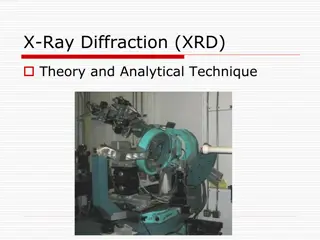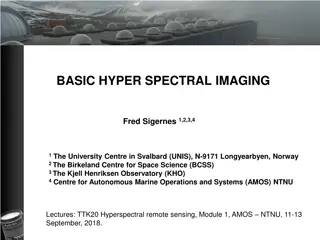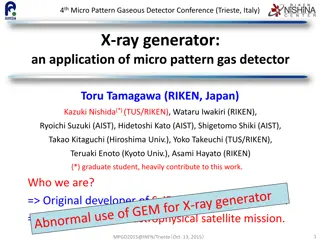Understanding X-Ray Diffraction Techniques in Materials Science
X-ray diffraction (XRD) analysis is a crucial technique in materials science for determining the crystallographic structure of materials. By irradiating a material with X-rays and measuring their intensities and scattering angles, XRD helps identify materials based on diffraction patterns. This method relies on constructive interference of monochromatic X-rays with crystalline samples, enabling rapid and powerful mineral identification. Despite its strengths like minimal sample preparation and straightforward data interpretation, XRD has limitations, such as needing homogeneous materials and access to standard reference files. Overall, XRD is a valuable tool for material analysis in various fields.
Download Presentation

Please find below an Image/Link to download the presentation.
The content on the website is provided AS IS for your information and personal use only. It may not be sold, licensed, or shared on other websites without obtaining consent from the author. Download presentation by click this link. If you encounter any issues during the download, it is possible that the publisher has removed the file from their server.
E N D
Presentation Transcript
X Ray diffraction X-ray diffraction analysis (XRD) is a technique used in materials science to determine the crystallographic structure of a material. XRD works by irradiating a material with incident X-rays and then measuring the intensities and scattering angles of the X-rays that leave the material. A primary use of XRD analysis is the identification of materials based on their diffraction pattern.
How does it Work? Crystal atoms scatter incident X-rays, primarily through interaction with the atoms electrons. This phenomenon is known as elastic scattering; the electron is known as the scatterer. A regular array of scatterers produces a regular array of spherical waves. In the majority of directions, these waves cancel each other out through destructive interference, however, they add constructively in a few specific directions, as determined by Bragg s law: 2dsin = n Where d is the spacing between diffracting planes, is the incident angle, n is an integer, is the beam wavelength. The specific directions appear as spots on the diffraction pattern called reflections.
Principle X-ray diffraction is based on constructive interference of monochromatic X-rays and a crystalline sample. These X-rays are generated by a cathode ray tube, filtered to produce monochromatic radiation, collimated to concentrate, and directed toward the sample. These diffracted X-rays are then detected, processed and counted. https://www.youtube.com/watch?v=QHMzFUo0NL8
Strengths and Limitations Strengths Powerful and rapid (< 20 min) technique for identification of an unknown mineral In most cases, it provides an unambiguous mineral determination Minimal sample preparation is required XRD units are widely available Data interpretation is relatively straight forward Limitations Homogeneous and single phase material is best for identification of an unknown Must have access to a standard reference file of inorganic compounds (d-spacings, hkls) Requires tenths of a gram of material which must be ground into a powder For mixed materials, detection limit is ~ 2% of sample For unit cell determinations, indexing of patterns for non-isometric crystal systems is complicated Peak overlay may occur and worsens for high angle 'reflections' Strengths Limitations

























